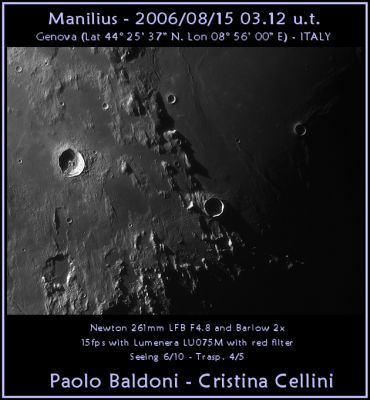Montes Haemus
Contents
Montes Haemus
|
Lat: 19.9°N, Long: 9.2°E, Diam: 560 km, Height: 2.43 km, Rükl: 23 |

Paolo Baldoni Montes Haemus is the band of peaks running diagonally through the middle of this image. It separates Mare Vaporum (on the left) from Mare Serenitatis (in shadows on the upper right, with parts of the rim of 15-km diameter crater Bessel lit by sunlight). The bright 38-km crater on the left is Manilius, and the deeply shadowed 26-km one at the foot of Montes Haemus is Menelaus. The old 46-km crater, below Manilius, in the lower left is Boscovich.
Images
LPOD Photo Gallery Lunar Orbiter Images Apollo Images
Sunrise at Montes Haemus
A sequence of orbital images of the sunrise terminator at the southeastern section of the partially sunlit Montes Haemus, as photographed during the mission of Apollo 17 in december 1972:
AS17-M-0606 Southwestern Mare Serenitatis, Bobillier, and Bessel.
AS17-M-0607 Bobillier at centre of frame. Note the ringlike appearances of Menelaus A and Sulpicius Gallus B near the frame's upper left corner (with illuminated peak of Sulpicius Gallus Alpha near the frame's upper margin).
AS17-M-0608 Menelaus A, Sulpicius Gallus B, Sulpicius Gallus Alpha.
AS17-M-0609 Menelaus A, Sulpicius Gallus B, Sulpicius Gallus Alpha.
AS17-M-0610 Menelaus A, Sulpicius Gallus B, Sulpicius Gallus Alpha.
AS17-M-0611 Sulpicius Gallus Alpha near the frame's lower margin.
The last ten or so frames of Apollo 17's REVOLUTION 27 (oblique northward looking Fairchild camera photographs) also show Montes Haemus during local sunrise.
Research Apollo 17 photography: Danny Caes
Maps
(LAC zone 41C3) LAC map Geologic map LM map LTO map
Description
Description: Wikipedia
Additional Information
Depth data from Kurt Fisher database
- Cherrington, 1969: 2.43 km
Nomenclature
- Haemus Mons was the ancient name for range the now known as the Balkans.
- According to Whitaker (p. 209), Montes Haemus was used by Hevelius, but for a feature different from the present one. Whitaker does not seem to specify what feature that was, or who first associated the name with the present feature. Who's Who in the Moon attributes the modern usage to Mädler, and says the name used by Hevelius was Haemus, Mons Thraciae.
- In the original IAU nomenclature of Blagg and Müller (1935), the name was Haemus, Mts.
- The name was Latinized to Montes Haemus in IAU Transactions XIIB (1964).
LPOD Articles
Bibliography
- Wood, C.A. Sep. 2001. Julius Caesar and the Haemus Mountains. S&T Sept 2001 v102 p108
- APOLLO OVER THE MOON; A VIEW FROM ORBIT, Chapter 3: The Terrae (Part 1), Figure 36.